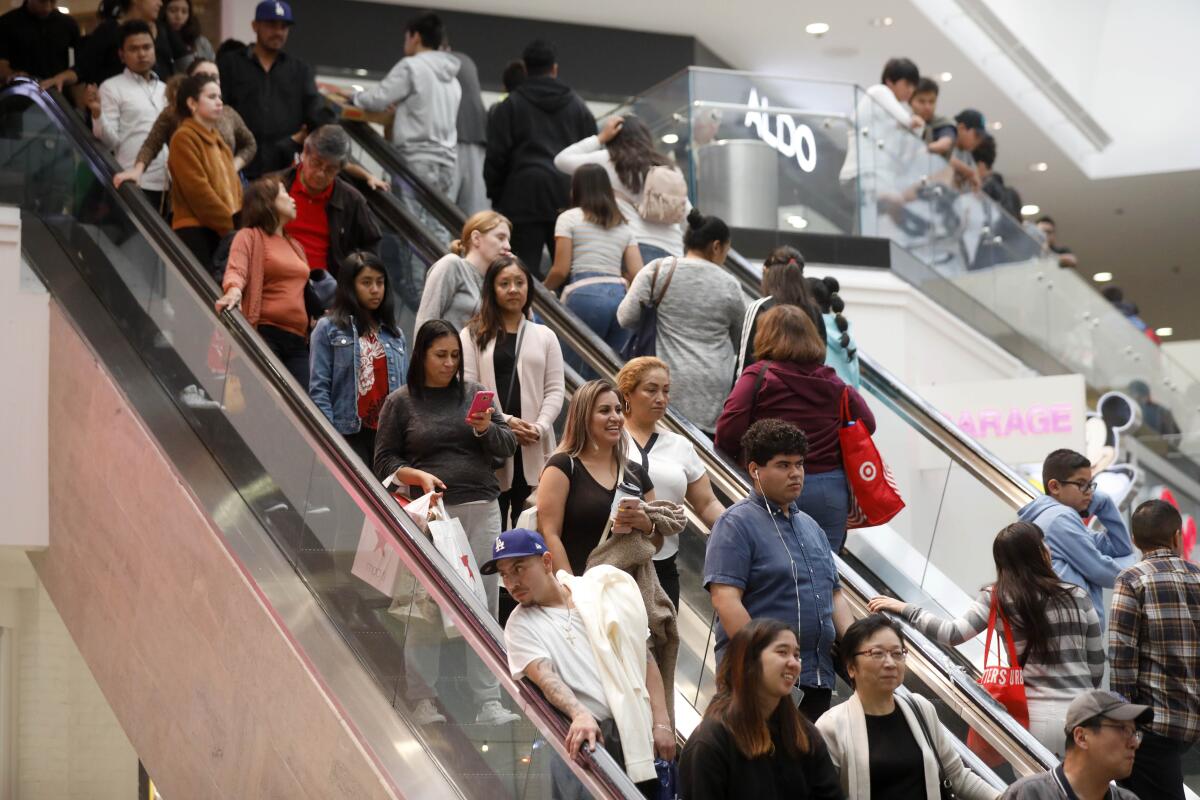Retailers plan for a Black Friday like no other

- Share via
Those tightly packed Black Friday lines that snake through the mall parking lot in the dead of night, past tents and lawn chairs and coolers stacked with still-warm Thanksgiving leftovers, are not exactly conducive to social distancing.
That puts retailers in a difficult position ahead of a hyped shopping day typically marked by frenzied crowds and predawn doorbuster deals. With COVID-19 cases surging across the country and public health officials urging Americans to stay home as much as possible — plus a new curfew covering 94% of Californians — in-store shopping on the day after Thanksgiving will be a subdued affair.
That’s leading to some mixed messaging from retailers: Come out on Black Friday, but not all at once. Consider just shopping online. Can’t get around to it this weekend? No problem — holiday discounts, which began earlier than ever, will continue for weeks.
“The power of Black Friday has been diminishing over the years and now, with COVID, is virtually nonexistent in stores and primarily moved to online,” said Marshal Cohen, chief industry analyst at market research firm NPD Group. “What COVID did was it forced what the inevitable already was to speed up.”
Last year’s Black Friday pulled in record online sales of $7.4 billion, a 19.6% increase over the previous year, according to data from Adobe. If projections are accurate, this Black Friday will blow past that, with online sales expected to generate $10.3 billion.
“We’ve rarely seen that much growth, but it’s unsurprising given the pandemic-driven surge to online shopping,” Adobe spokesman Kevin Fu said.
With retailers hampered by temporary store closures, capacity limits and stay-at-home orders since March, many have been pointing shoppers online for months. They’ve also been spreading holiday deals out, starting as early as October and promising to keep them going well into December.
Retail watchers say that despite a challenging year, there are signs that pent-up demand and “guilt gifting” will boost sales during the all-important end-of-year period.
The National Retail Federation on Monday forecast that November-to-December holiday sales, which combine in-store and online activity, would total $755.3 billion to $766.7 billion. That would reflect a year-over-year increase of 3.6% to 5.2%, outpacing the average holiday sales increase of 3.5% over the last five years.
“There is uncertainty about consumers’ willingness to spend, but with the economy improving, most have the ability to spend,” Jack Kleinhenz, the retail federation’s chief economist, said in a statement. “After all they’ve been through, we think there’s going to be a psychological factor that they owe it to themselves and their families to have a better-than-normal holiday.”
Hot gift categories include technology, small domestic appliances, housewares, toys and do-it-yourself auto projects, which Cohen summarized as things that help you “live a better life while you’re at home,” given that Americans will probably continue to spend a lot of their time there next year. Along those lines, apparel sales are expected to be weak — with the exception of sleepwear and slippers, he said.
Although the importance of Black Friday has been waning for years, it was still the top shopping day in 2019, according to the NPD Group.
How many shoppers will venture out is impossible to predict. But consumers have been conditioned to think of Black Friday as a day to shop, and stores have been carefully preparing to welcome those who do show up — albeit with a slew of rules and restrictions.
Westfield has been doing dry runs ahead of the big day, said Molly Unger, vice president of shopping center management. The company will have traffic counters at all of its 29 U.S. malls — those in Los Angeles County, such as Westfield Century City and Westfield Topanga, are currently limited to 25% capacity — and will restrict entry at the doors or at its garages, or block off parking spaces, if too many people arrive at once.
“They’re ready and they’ve been practicing,” she said. “It’s not about closing the centers down, it’s about slowing down the intake of people coming in.”
In-store and curbside pickup options will help customers get in and out quickly, and Unger doesn’t expect many to leisurely browse as in years past.
“We’ve seen customers’ behavior change,” she said. “It’s still a social experience to go to a mall, but they’re mission-oriented. They’re not just coming to hang out.”
That will almost certainly hurt in-store sales around the country by dramatically reducing impulse buying, Cohen said.
“Black Friday won’t be as big as what we’ve seen,” he said. “There will be plenty of people who will shop, don’t get me wrong, but you won’t see that mad dash, that mass hysteria that usually occurs. That’s gone.”
More to Read
Inside the business of entertainment
The Wide Shot brings you news, analysis and insights on everything from streaming wars to production — and what it all means for the future.
You may occasionally receive promotional content from the Los Angeles Times.











